Guide to Dinosaur Mummy CSI

What is a dinosaur mummy?
When a dinosaur dies, it normally becomes a meal for many animals on a very long food chain. Other dinosaurs, reptiles, mammals, insects and microbes will feast on the carcass. They will eat the meat, and often the bones as well. That is why we are not up to our eyeballs in dinosaur fossils. Occasionally, and it happened very rarely, bones are preserved by the process of fossilization. Fossilization is when some kind of rock replaces the bone over a very long period of time. This is what people are used to seeing in museums – bone that has turned to stone through fossilization. The rarest type of fossilization is when soft tissues, such as skin, are preserved. Even then, it is usually just small patches of skin, those small parts that weren’t eaten. In the case of the dinosaur mummy known as Leonardo, shown in the Dinosaur Mummy CSI exhibit, his entire body became a mummy before it fossilized, preserving his skin, bones and even organs and his final meals. If you click on the picture at left, you can clearly see the difference between a dinosaur skeleton and a dinosaur mummy. Leonardo is on the right and the skeleton on the left is the same type of dinosaur, a Brachylophosaurus, as Leonardo.
When a dinosaur dies, it normally becomes a meal for many animals on a very long food chain. Other dinosaurs, reptiles, mammals, insects and microbes will feast on the carcass. They will eat the meat, and often the bones as well. That is why we are not up to our eyeballs in dinosaur fossils. Occasionally, and it happened very rarely, bones are preserved by the process of fossilization. Fossilization is when some kind of rock replaces the bone over a very long period of time. This is what people are used to seeing in museums – bone that has turned to stone through fossilization. The rarest type of fossilization is when soft tissues, such as skin, are preserved. Even then, it is usually just small patches of skin, those small parts that weren’t eaten. In the case of the dinosaur mummy known as Leonardo, shown in the Dinosaur Mummy CSI exhibit, his entire body became a mummy before it fossilized, preserving his skin, bones and even organs and his final meals. If you click on the picture at left, you can clearly see the difference between a dinosaur skeleton and a dinosaur mummy. Leonardo is on the right and the skeleton on the left is the same type of dinosaur, a Brachylophosaurus, as Leonardo.
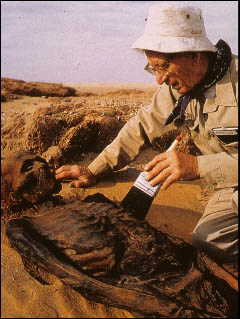
How did Leonardo become a mummy?
Paleontologists study rocks and very old, dead things. But they don’t really need to know much about mummies because they are so incredibly rare. When the dinosaur mummy was found, it presented the paleontology team with a unique problem. It had been nearly 100 years since the last mummified dinosaur had been discovered, and that one just had patches of skin. There was no one left who had done research on this type of fossil. And that long-ago discovery was far less complete that Leonardo. After scratching their heads and tossing around a few ideas, they decided to do the smart thing. They called Dr. Art Aufderheide, the man who literally wrote the book on mummies – the human kind. On the right is a photo of Dr. Aufderheide with one of his human friends.
Dr. Aufderheide traveled to Montana and met with members of the science team studying the dinosaur mummy. He was amazed at the fossil and how well preserved it was. After asking the paleontologists a few questions, he gave them a theory that seems to fit the evidence and explain how this remarkable fossil was created. The short version of the story is that Dr. Aufderheide believes Leonardo was a “wet mummification”. This means that after he died, probably from a combination of a bite wound and drowning, the river he was in flooded, carrying huge amounts of sand that covered his body. As the floodwaters receded, his covered body was left at the bottom of a pool of water that was also filled with the branches of the conifer trees that were common in the area. We know they were common because we find them in his stomach as a part of his last meal. As these branches decomposed in the water, chemicals found in conifer leaves leached into the water and seeped into Leonardo’s body. One of these chemicals is called aldehyde. This is a chemical that ancient Egyptians used for preserving bodies during the mummification process. So, over time, Leonardo’s body was likely repeatedly “treated” with aldehydes, preventing decay and allowing for the body to slowly mummify. This process may have taken decades and a series of storms. It is easy to see that this was a very unique set of circumstances and that’s why this is the only fossil every found with this type of preservation.
Paleontologists study rocks and very old, dead things. But they don’t really need to know much about mummies because they are so incredibly rare. When the dinosaur mummy was found, it presented the paleontology team with a unique problem. It had been nearly 100 years since the last mummified dinosaur had been discovered, and that one just had patches of skin. There was no one left who had done research on this type of fossil. And that long-ago discovery was far less complete that Leonardo. After scratching their heads and tossing around a few ideas, they decided to do the smart thing. They called Dr. Art Aufderheide, the man who literally wrote the book on mummies – the human kind. On the right is a photo of Dr. Aufderheide with one of his human friends.
Dr. Aufderheide traveled to Montana and met with members of the science team studying the dinosaur mummy. He was amazed at the fossil and how well preserved it was. After asking the paleontologists a few questions, he gave them a theory that seems to fit the evidence and explain how this remarkable fossil was created. The short version of the story is that Dr. Aufderheide believes Leonardo was a “wet mummification”. This means that after he died, probably from a combination of a bite wound and drowning, the river he was in flooded, carrying huge amounts of sand that covered his body. As the floodwaters receded, his covered body was left at the bottom of a pool of water that was also filled with the branches of the conifer trees that were common in the area. We know they were common because we find them in his stomach as a part of his last meal. As these branches decomposed in the water, chemicals found in conifer leaves leached into the water and seeped into Leonardo’s body. One of these chemicals is called aldehyde. This is a chemical that ancient Egyptians used for preserving bodies during the mummification process. So, over time, Leonardo’s body was likely repeatedly “treated” with aldehydes, preventing decay and allowing for the body to slowly mummify. This process may have taken decades and a series of storms. It is easy to see that this was a very unique set of circumstances and that’s why this is the only fossil every found with this type of preservation.
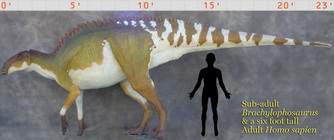
What kind of dinosaur is the Dinosaur Mummy?
The Dinosaur Mummy is a Brachylophosaurus canadensis, a member of the plant-eating hadrosaur family. These types of dinosaurs are also called “Duckbilled Dinosaurs” because they had a large, flat beak. The name Brachylophosaurus means “short crested lizard”. They are so named because of the short, flat crest – more like a flap – on top of their head. This crest probably could have air blown over it to make sounds for communication. The species name canadensis was given because the first, or type, specimen of this dinosaur was found in Canada.
How big was the Dinosaur Mummy and why does he look so small?
When he was alive, the dinosaur mummy was about 23 feet long and 9 feet tall at his shoulder. In the Xray that is shown his entire tail is missing. It was there when he died, but part of it broke off shortly before he was discovered. This happened as the fossil was eroding from the cliff where he was discovered. There is a section of his tail that was discovered intact, you can see it in the three-dimensional model created from the scans of the fossil. He looks small now because he shriveled up as he became a mummy. If you look at a human mummy, you can see that when all the water leaves a body, the skin and muscles shrink quite a bit. The skin looks like it is just clinging in a thin layer over bones. Also, the discs that separated the dinosaur’s vertebrae have also disappeared, making the fossil look considerably shorter. That is what we see in much of the dinosaur mummy. So his bones are the same size as when he was alive, but all the soft tissue on his body has shrunk, making him look quite a bit smaller.
How long ago did the Dinosaur Mummy live?
The dinosaur mummy lived about 77 million years ago. This was about 12 million years before the end of the age of the dinosaurs that lived on land. This was the later part of the Cretaceous Period of the Earth’s geologic time.
Why is it important that we know what he ate?
The dinosaur mummy has revealed more to paleontologists and paleobiologists than any other dinosaur fossil. By studying the contents of his stomach, which are the first ever discovered in a plant eating dinosaur, scientists can tell exactly what his prehistoric world looked like. More that 40 different kinds of plants were found in his stomach and intestines. These include the leaves of trees, flowers, ferns, shrubs and even algae that he swallowed getting a drink of water. Until Leonardo was discovered, scientists could only guess at how a specific prehistoric environment looked with regard to its plants.
The Dinosaur Mummy is a Brachylophosaurus canadensis, a member of the plant-eating hadrosaur family. These types of dinosaurs are also called “Duckbilled Dinosaurs” because they had a large, flat beak. The name Brachylophosaurus means “short crested lizard”. They are so named because of the short, flat crest – more like a flap – on top of their head. This crest probably could have air blown over it to make sounds for communication. The species name canadensis was given because the first, or type, specimen of this dinosaur was found in Canada.
How big was the Dinosaur Mummy and why does he look so small?
When he was alive, the dinosaur mummy was about 23 feet long and 9 feet tall at his shoulder. In the Xray that is shown his entire tail is missing. It was there when he died, but part of it broke off shortly before he was discovered. This happened as the fossil was eroding from the cliff where he was discovered. There is a section of his tail that was discovered intact, you can see it in the three-dimensional model created from the scans of the fossil. He looks small now because he shriveled up as he became a mummy. If you look at a human mummy, you can see that when all the water leaves a body, the skin and muscles shrink quite a bit. The skin looks like it is just clinging in a thin layer over bones. Also, the discs that separated the dinosaur’s vertebrae have also disappeared, making the fossil look considerably shorter. That is what we see in much of the dinosaur mummy. So his bones are the same size as when he was alive, but all the soft tissue on his body has shrunk, making him look quite a bit smaller.
How long ago did the Dinosaur Mummy live?
The dinosaur mummy lived about 77 million years ago. This was about 12 million years before the end of the age of the dinosaurs that lived on land. This was the later part of the Cretaceous Period of the Earth’s geologic time.
Why is it important that we know what he ate?
The dinosaur mummy has revealed more to paleontologists and paleobiologists than any other dinosaur fossil. By studying the contents of his stomach, which are the first ever discovered in a plant eating dinosaur, scientists can tell exactly what his prehistoric world looked like. More that 40 different kinds of plants were found in his stomach and intestines. These include the leaves of trees, flowers, ferns, shrubs and even algae that he swallowed getting a drink of water. Until Leonardo was discovered, scientists could only guess at how a specific prehistoric environment looked with regard to its plants.
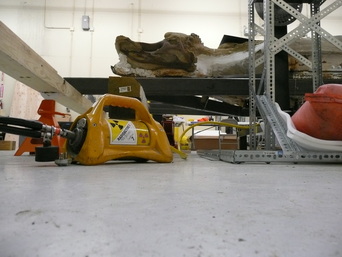
What kind of Xrays were used to look inside the fossil?
The science team used several different types of radiation to create the Xrays of the dinosaur mummy. The first they used was a water-cooled Xray tube. This is similar to what is used to take Xrays of people, only it is about 5,000 times more powerful. This kind of power was needed because it had to look through more than two feet of rock. Even this wasn’t powerful enough, so the team took Leonardo down to Houston, Texas were NASA made room for him in a special lead-lined jet hangar at the Johnson Space Center. While there, the science team used Iridium and Cobalt radiation to look inside the fossil. You can click on the photo at right for a larger picture of the radioactive material being positioned under the fossil. The yellow container holds a small but highly radioactive isotope. The Cobalt in particular was extremely powerful. The science team had to leave the building and hide behind another building to be certain they were safe from the radiation. However, the most powerful radiation used in the study of the fossil was used on Leonardo’s arm. A Linear Accelerator fired radiation at the fossil at Stanford University’s SLAC (Stanford Linear Accelerator Center) also known as the National Accelerator Laboratory. Yes, Leonardo is important enough of a fossil to have these kind of resources used in the research!
How was the digital image of the fossil created?
The Dinosaur Mummy was the first dinosaur to be replicated in an entirely new way. Because the skin on the surface of Leonardo was so fragile, if the mold necessary to make casts, or replicas, of the fossil had been created in the same way it has been done for many years, the skin would have been damaged or destroyed. This made the traditional method of pouring silicon rubber on the fossil and peeling it off out of the question. The science team had to come up with another way. The answer was a new technology called White Light Scanning. A grid of light and shadow was projected on the fossil and special cameras recorded this grid and the surface of the fossil in 3D. The resolution of the cameras is thinner than a human hair, so that the digital information they provided shows every fine detail of the original fossil. This digital 3D model can be seen on the main exhibit display as the reddish-orange image. This information was then used by a computer to control a machine called a rapid prototyper that was able to make a perfect replica of the dinosaur mummy without any possibility of damaging the original fossil.
The science team used several different types of radiation to create the Xrays of the dinosaur mummy. The first they used was a water-cooled Xray tube. This is similar to what is used to take Xrays of people, only it is about 5,000 times more powerful. This kind of power was needed because it had to look through more than two feet of rock. Even this wasn’t powerful enough, so the team took Leonardo down to Houston, Texas were NASA made room for him in a special lead-lined jet hangar at the Johnson Space Center. While there, the science team used Iridium and Cobalt radiation to look inside the fossil. You can click on the photo at right for a larger picture of the radioactive material being positioned under the fossil. The yellow container holds a small but highly radioactive isotope. The Cobalt in particular was extremely powerful. The science team had to leave the building and hide behind another building to be certain they were safe from the radiation. However, the most powerful radiation used in the study of the fossil was used on Leonardo’s arm. A Linear Accelerator fired radiation at the fossil at Stanford University’s SLAC (Stanford Linear Accelerator Center) also known as the National Accelerator Laboratory. Yes, Leonardo is important enough of a fossil to have these kind of resources used in the research!
How was the digital image of the fossil created?
The Dinosaur Mummy was the first dinosaur to be replicated in an entirely new way. Because the skin on the surface of Leonardo was so fragile, if the mold necessary to make casts, or replicas, of the fossil had been created in the same way it has been done for many years, the skin would have been damaged or destroyed. This made the traditional method of pouring silicon rubber on the fossil and peeling it off out of the question. The science team had to come up with another way. The answer was a new technology called White Light Scanning. A grid of light and shadow was projected on the fossil and special cameras recorded this grid and the surface of the fossil in 3D. The resolution of the cameras is thinner than a human hair, so that the digital information they provided shows every fine detail of the original fossil. This digital 3D model can be seen on the main exhibit display as the reddish-orange image. This information was then used by a computer to control a machine called a rapid prototyper that was able to make a perfect replica of the dinosaur mummy without any possibility of damaging the original fossil.
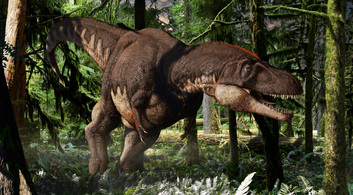
What kind of dinosaur bit him before he died?
It took nearly six years for the science team to discover that the dinosaur mummy had a pretty serious bite wound on his right side. It wasn’t until the powerful Xrays taken at NASA’s Johnson Space Center in Houston revealed that his ribs had been seriously damaged that it became obvious he had been bitten. The skin on the outside of his body didn’t show the wound opening as it seems to have closed up after the bite occurred. Since there was no healing of the bones after the bite, it likely happened just hours, or even minutes, before he died. There were only a couple of dinosaurs that lived at that time and place that could have inflicted such a serious wound, and both were early members of the tyrannosaur family – ancestors of the very famous T. rex. One was called Daspletosaurus and the other was called Gorgosaurus. Both looked almost exactly like a slightly smaller version of T. rex, growing to about 35 feet long as an adult. You can click on the image of Daspletosaurus, created by paleoartist Julius Csotonyi, for a closer look.
It took nearly six years for the science team to discover that the dinosaur mummy had a pretty serious bite wound on his right side. It wasn’t until the powerful Xrays taken at NASA’s Johnson Space Center in Houston revealed that his ribs had been seriously damaged that it became obvious he had been bitten. The skin on the outside of his body didn’t show the wound opening as it seems to have closed up after the bite occurred. Since there was no healing of the bones after the bite, it likely happened just hours, or even minutes, before he died. There were only a couple of dinosaurs that lived at that time and place that could have inflicted such a serious wound, and both were early members of the tyrannosaur family – ancestors of the very famous T. rex. One was called Daspletosaurus and the other was called Gorgosaurus. Both looked almost exactly like a slightly smaller version of T. rex, growing to about 35 feet long as an adult. You can click on the image of Daspletosaurus, created by paleoartist Julius Csotonyi, for a closer look.
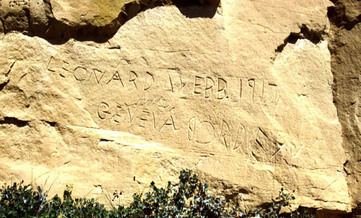
Where was the dinosaur mummy fossil found?
Leonardo was found in a small canyon on a very large cattle ranch in the north-eastern part of Montana. A doctor from North Dakota was on a fossil hunting vacation with his daughter when he spotted a reddish mark on the face of a short cliff. The mark looked to the doctor like an X-ray of a pelvis. It was fortunate that it was a doctor who spotted this.
How did he get the name Leonardo?
In 1917, a Montana cowboy named Leonard Webb carved his name, the date and the name of his girlfriend, Geneva Jordan, into a sandstone rock in the badlands of Montana. This rock was found a short distance from the spot where the dinosaur mummy was discovered. For about 2 hours the team of dinosaur hunters that were uncovering the dinosaur mummy called him Leonard. They thought that sounded kind of goofy, so Dr. Stephenson, who actually discovered the fossil, suggested the name “Leonardo” as it sounded more distinguished. The photo at right shows the carved sandstone that gave this dinosaur his name.
Leonardo was found in a small canyon on a very large cattle ranch in the north-eastern part of Montana. A doctor from North Dakota was on a fossil hunting vacation with his daughter when he spotted a reddish mark on the face of a short cliff. The mark looked to the doctor like an X-ray of a pelvis. It was fortunate that it was a doctor who spotted this.
How did he get the name Leonardo?
In 1917, a Montana cowboy named Leonard Webb carved his name, the date and the name of his girlfriend, Geneva Jordan, into a sandstone rock in the badlands of Montana. This rock was found a short distance from the spot where the dinosaur mummy was discovered. For about 2 hours the team of dinosaur hunters that were uncovering the dinosaur mummy called him Leonard. They thought that sounded kind of goofy, so Dr. Stephenson, who actually discovered the fossil, suggested the name “Leonardo” as it sounded more distinguished. The photo at right shows the carved sandstone that gave this dinosaur his name.
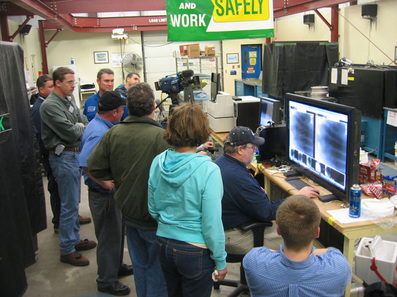
Why don’t you just cut the fossil open to see what is inside?
During the course of the study of the dinosaur mummy, some of the researchers were becoming impatient. It was frustrating to know that inside this fossil there were secrets that could answer many questions about dinosaurs and the prehistoric past. Cutting up and dissecting this wonderful fossil would surely advance the science and our understanding of prehistory. However, there was always the concern that, once the fossil was essentially destroyed by cutting it open, and information gathered, what then? What if, in 10 or 20 years, new investigative technologies are available that we can’t even imagine today? After all, the research program that studied the dinosaur mummy in 2007 was unimaginable to the scientists in 1907 that were looking at the partially mummified dinosaur carcass at the American Museum of Natural History. Some of the preservation techniques they used back then make it impossible for certain tests to be conducted on that fossil using today’s technologies. The team studying Leonardo made a difficult, but important, decision to not only keep the dinosaur mummy intact, but to leave one side of him completely untouched. This way, the next generation of paleontologists will have an opportunity to study one of the most important dinosaur discoveries of all time. The photo at left shows a few of the science team watching the video screen as new images of the dinosaur mummy's interior are created. Also in the photo is shuttle astronaut Stan Love, one of the many science fans who want to see and learn more about Leonardo.
During the course of the study of the dinosaur mummy, some of the researchers were becoming impatient. It was frustrating to know that inside this fossil there were secrets that could answer many questions about dinosaurs and the prehistoric past. Cutting up and dissecting this wonderful fossil would surely advance the science and our understanding of prehistory. However, there was always the concern that, once the fossil was essentially destroyed by cutting it open, and information gathered, what then? What if, in 10 or 20 years, new investigative technologies are available that we can’t even imagine today? After all, the research program that studied the dinosaur mummy in 2007 was unimaginable to the scientists in 1907 that were looking at the partially mummified dinosaur carcass at the American Museum of Natural History. Some of the preservation techniques they used back then make it impossible for certain tests to be conducted on that fossil using today’s technologies. The team studying Leonardo made a difficult, but important, decision to not only keep the dinosaur mummy intact, but to leave one side of him completely untouched. This way, the next generation of paleontologists will have an opportunity to study one of the most important dinosaur discoveries of all time. The photo at left shows a few of the science team watching the video screen as new images of the dinosaur mummy's interior are created. Also in the photo is shuttle astronaut Stan Love, one of the many science fans who want to see and learn more about Leonardo.

